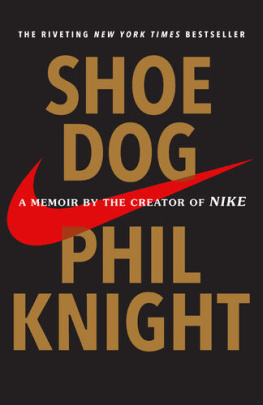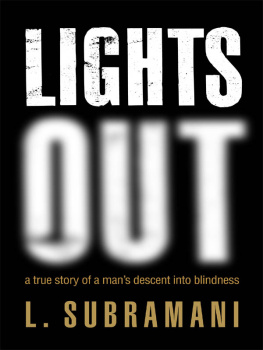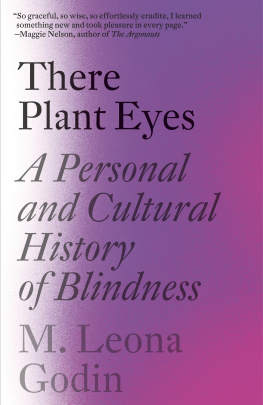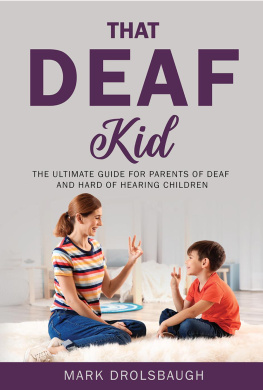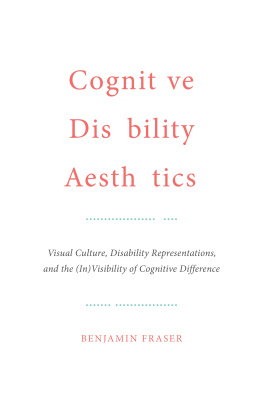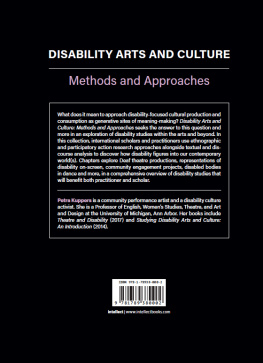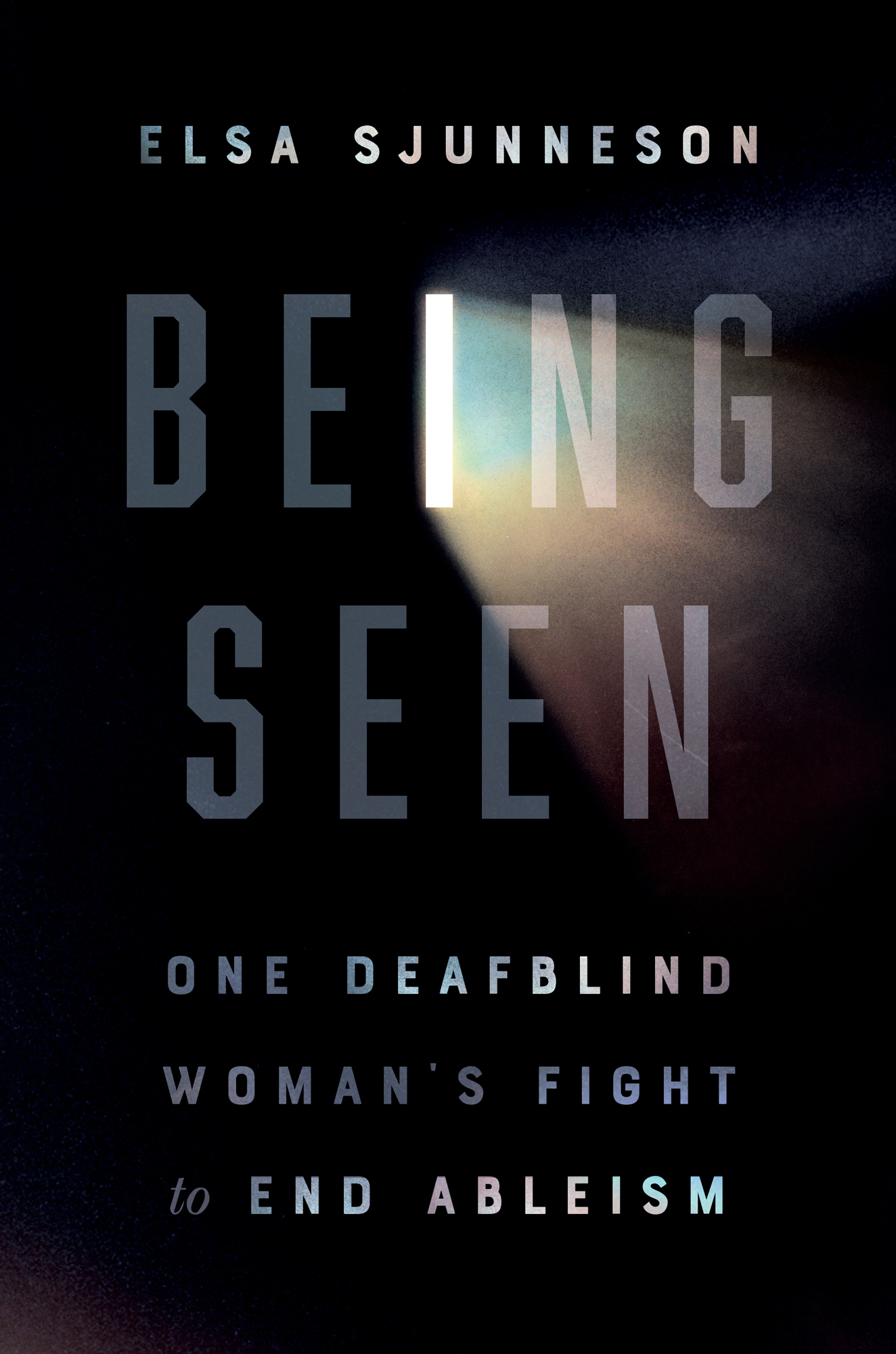Contents
Guide
Elsa Sjunneson
Being Seen
One Deafblind Womans Fight to End Ableism

An Imprint of Simon & Schuster, Inc.
1230 Avenue of the Americas
New York, NY 10020
www.SimonandSchuster.com
Copyright 2021 by Elsa Sjunneson
All rights reserved, including the right to reproduce this book or portions thereof in any form whatsoever. For information, address Simon & Schuster Subsidiary Rights Department, 1230 Avenue of the Americas, New York, NY 10020.
First Tiller Press hardcover edition October 2021
TILLER PRESS and colophon are registered trademarks of Simon & Schuster, Inc.
For information about special discounts for bulk purchases, please contact Simon & Schuster Special Sales at 1-866-506-1949 or .
The Simon & Schuster Speakers Bureau can bring authors to your live event. For more information or to book an event, contact the Simon & Schuster Speakers Bureau at 1-866-248-3049 or visit our website at www.simonspeakers.com.
Interior design by Laura Levatino
Jacket design by Patrick Sullivan
Author photo by Lis Mitchell
Library of Congress Cataloging-in-Publication Data has been applied for.
ISBN 978-1-9821-5237-6
ISBN 978-1-9821-5241-3 (ebook)
To everyone who said you cant you shouldnt please, dont.
I can. I should. I did.
Thank you for teaching me to be stubborn.
And for Deafblind women everywhere, living in liminal space.
Authors Note
With the exception of historical and public figures, all names have been changed. Personal conversations and events in this book have been constructed from memory to the best of my ability.
CONTENT WARNING: This book contains explicit depictions of ableism; school bullying; sexual assault and abuse and references to caregiver murder; police brutality; emotional abuse; physical abuse. For detailed content warnings for each chapter, please visit the authors website.
1. The Building Blocks of Blindness
Hi, Im Elsa.
E veryone has always assumed that I will die young. At this point in my midthirties, Im no longer convinced theyre right. I spent a long time imagining how I was going to die. It was always an accident. The people who love me probably think about it more than I do. I see it in their faces.
I understand. Theyre not wishing for my death; in fact, theyre dreading it. But as anybody who cares about me knows, Im going to continue running off and living my life exactly the way I want to, and I wont let something as benign as the body I was born in stop me.
I get portents of my death every once in a while. Maybe this time I wont notice when a car turns on a red. Maybe I wont hear someone shouting to watch where Im going. Ive taken harrowing falls, narrowly escaped speeding cars, gone swimming where I shouldnt. Ive attempted to live my life like a nondisabled person, sometimes to a dangerous degree. There are things that stop me, of course, but I dont wake up in the morning wondering whats going to kill me because of my sight or hearing that day. Ive moved fully into the realm of the living.
Thats because Ive learned how to survive in a body that wasnt intended for the world I live in. Im certain of almost every step I take, certain that my adaptive aids will carry me through. Until 2020, when I stopped being able to control my environment in the ways that keep me alive. When all my adaptive aids failed in the span of four weeks. When I had to reconfigure my understanding of my body.
It was four weeks into the shelter-in-place order in Seattle, Washington, when one of my hearing aids failed me. The important one, of course. Three days before that, my guide dog broke his toe while playing with the neighbor dog. I had recently moved back to the Central District, where I had grown up, so at least I knew the neighborhood, but it wasnt the house Id lived in before.
For the first time in a decade, I was actively Deafblind again. Stripped bare of my adaptive aids, I had to start asking myself some difficult questions. How comfortable was I walking with a white cane to the audiologist without working hearing aids, instead of asking my mom or my neighbor to take me? Could I cross the street by myself, without my dog?
I had to remember what it was like to be Deafblind without assistance, and I quickly realized that it was the perfect time to remember what it is that makes me a Deafblind person at all.
It is the measure of distance, between me and the nondisabled people who surround me, who sharply define the boundaries of my world. Not my body. Not merely nondisabled society at large, but individuals who make specific decisions that leave me stranded in their wake.
It is the fact that I cannot effectively communicate when someone is across a silent room, with no audible distractions, without a hearing aid. Even with aids, add a plexiglass barrier between me and a cashier (who also happens to be wearing a mask) and Im sunk.
It is the fact that without a guide dog, I feel disconnected, my body seeking anchors. I can still see, but perception is not the same thing as seeing sharply into the distance.
But it doesnt have to be that way. I feel that way because of what I have been told is expected of my body and what the norms are for human interaction and ability.
And, most important, because of what people expect when they hear the word Deafblind.
Hi. My name is Elsa R. Sjunneson. Im Deafblind.
What do you think being Deafblind means?
If youre a nondisabled, fully sighted, fully hearing person, you may have some very specific ideas of what Deafblindness looks like. Perhaps youve read about Helen Keller, the most famous historical example. Or you might have read Haben Girmas book. Or maybe youve actually heard of Laura Bridgman.
If youre disabled (either invisibly or visibly, via physical or mental or other means), you may also have some perceptions that need altering. After all, the disability community is not a monolith.
If you have met someone who is Deafblind, I want you to think about what they looked like, what adaptive devices they used, how they adapted to the world around them.
If you havent, I want you to imagine it.
Cant picture it? Cant picture me? Lets try an exercise of the imagination.
What does a blind person look like to you? Do they wear dark glasses? Carry a white cane or have a guide dog? Are their eye sockets empty, or does a cloudy cataracted pair of eyes live within their ocular sphere? Do you know? Are they wearing sunglasses or prescription lenses?
What does a D/deaf person look like? Can you even tell if theyre D/deaf until they turn up their hearing aids, or until they sign?
Okay, now flip to the back of this book. Take a look at the headshot on the back cover. Ill wait.
Do I look Deafblind to you?
I know.
I dont, do I?
I look at the camera, not away from it. I have one gray eye with a pupil and the other is clouded by a cataract, aqua blue and white. I wear glasses, theyre stylish and frame my face well. My hearing aids are pink and gray and dont hide behind my hair. My makeup is doneIm wearing deep pink lipstick, a white and black striped silk blouse and leather vest. Vintage chic, and yes I styled myself.
I get it. To you this doesnt look like a Deafblind person. Im often stopped in the street, told that I look great for a blind person. Im often asked if my caretakers have dressed me (my ex-husband Gatsby even received compliments for it!).

